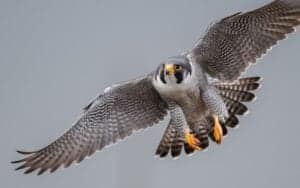Minnesota is home to many flying animals, but many are not very dangerous to people. Some creatures may pose a slight threat in certain situations, but this usually only involves at-risk people (such as those allergic to bees).
That said, there are practically no exceptionally dangerous animals in Minnesota. Instead, your most dangerous flying animal is probably the mosquito, which can carry many diseases. There are also several formidable birds of prey, which can be hazardous in some situations.
We’ll look at the few more dangerous animals that fly in Minnesota while also discussing ways to avoid danger outdoors.
Are Minnesota’s Skies Dangerous?
Minnesota’s skies are not inherently dangerous. Some animals can potentially harm humans, like birds of prey. However, no animals fly around Minnesota trying to harm humans. Instead, most aggression is defensive, such as when the birds try to protect their nesting area.
The most dangerous flying animal is the mosquito, which can transmit diseases such as Zika. However, you can do many different things to limit your potential exposure to bites.
There is no reason to keep your eyes on the sky in Minnesota.
A List of the Top 8 Most Dangerous Flying Animals in Minnesota
1. Bald Eagles

These birds aren’t direct threats to humans but can be territorial.
©WebGuNet/Shutterstock.com
Bald eagles are one of North America’s most iconic birds of prey. They are instantly recognizable thanks to their striking appearance. Their white head and tail feathers make them easy to identify. Those who have never seen a bald eagle can easily identify them.
Bald eagles are skilled hunters who usually hunt for fish but can also prey on birds, mammals, and carrion if needed. They like to sit near water sources and use their excellent vision to spot fish swimming near the surface. They have sharp talons and strong beaks that allow them to grab fish from the water or engage in high-flying fights to snatch prey from birds like ospreys.
These hunting skills can make them seem quite formidable. However, they are luckily not very aggressive towards humans. They are known for taking advantage of some human activities, though. For instance, they may scavenge near fishing spots or even garbage dumps. This behavior can put them in contact with people.
They are most aggressive during the nesting season, which stretches from late winter to early summer. During this time, they may be territorial. Therefore, it’s essential to give them plenty of space and avoid disturbing their nests.
In rare cases, bald eagles can pose a threat to small pets. They may see small dogs as prey, for instance.
2. Great Horned Owls
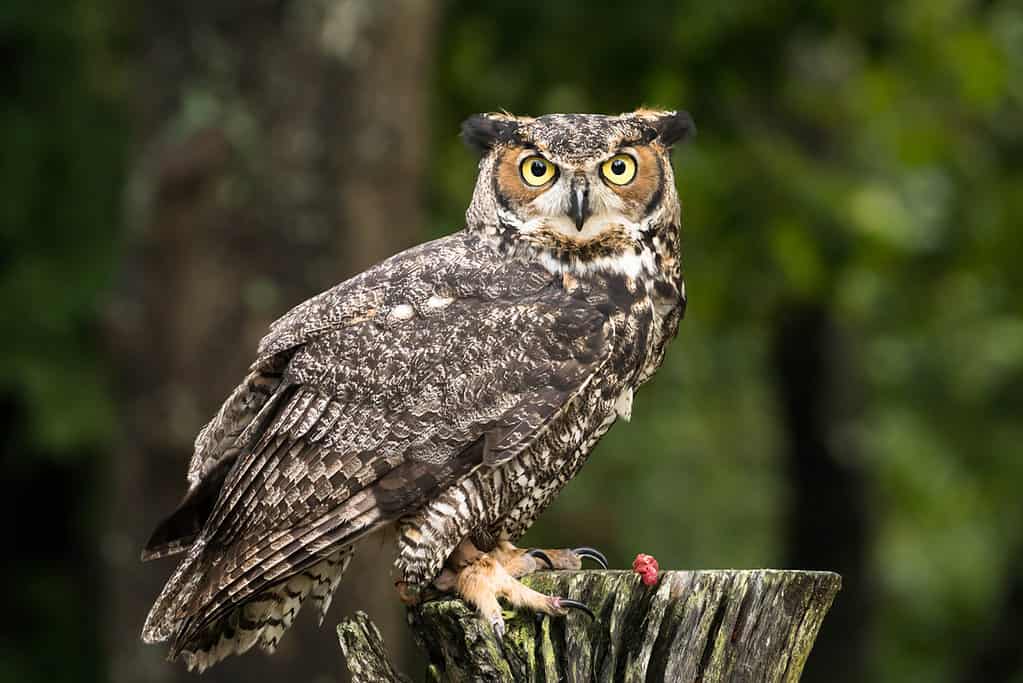
Owls tend to be most active at night when most dangerous encounters happen.
©iStock.com/makasana
The great horned owl is known for its nocturnal stealth. While these birds are native to Minnesota, they aren’t regularly seen by people.
They’re named after their prominent horn-like tufts of feathers on their head, so they don’t actually have ears. These owls are exceptionally large, which is why they can sometimes be a threat to humans.
Great horned owls are apex predators, meaning they don’t have any predators. They have a varied diet, including anything from small mammals to birds to skunks. They possess superb vision adapted for low light, and their ability to fly silently due to specialized wing feathers allows them to approach their prey stealthily.
These owls are often seen perched in trees or on utility poles, waiting patiently for an opportunity to swoop down on unsuspecting prey. Minnesota’s hunting grounds often include wooded areas, open fields, and suburban neighborhoods. They are opportunistic, so they will eat anything small enough to consume.
Still, their primary targets are usually rodents.
Great horned owls aren’t a direct threat to humans. There are some instances you should approach with caution, though. During the breeding season, which usually occurs from January to April in Minnesota, these owls become more territorial and protective of their nests and young. Approaching a nesting great horned owl can provoke defensive behavior, including hissing, clacking their beaks, and occasionally swooping at perceived threats.
It’s best to always keep your distance, like you should do for any wild animal.
3. Red-Tailed Hawk
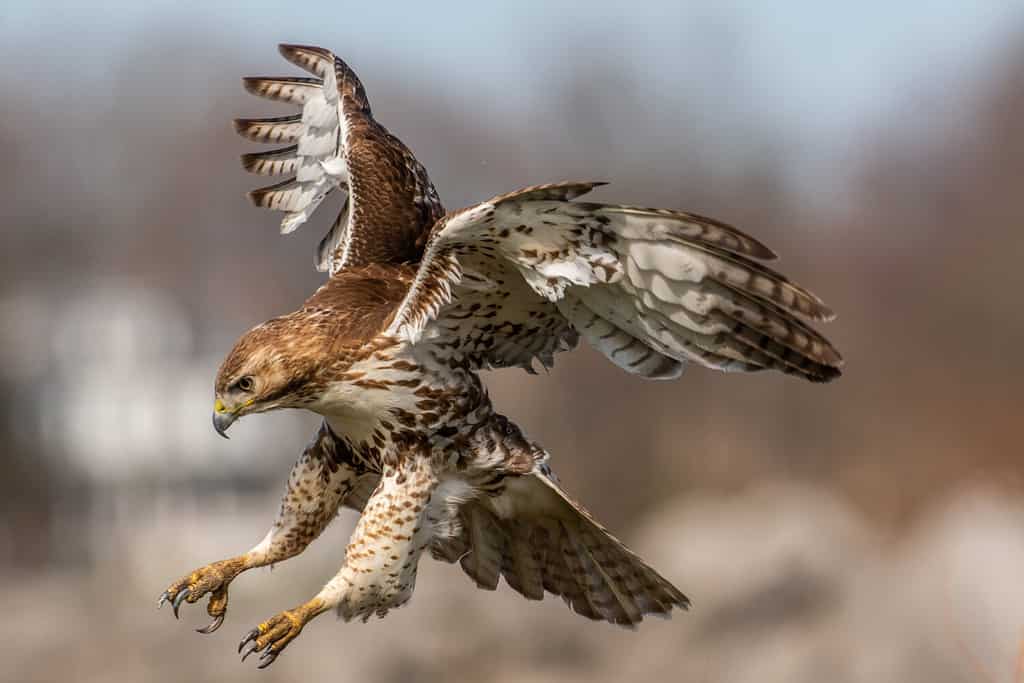
Red-tailed hawks have exceptionally sharp talons, which can be dangerous.
©David Brace/Shutterstock.com
The red-tailed hawk is another prominent raptor species found throughout North America, including Minnesota. As their name suggests, they have reddish-brown tail feathers, which you can use to identify them. They are powerful, skilled predators, but they aren’t usually dangerous to people.
Usually, you’ll spot these hawks high in the air, where they rid thermal updrafts in search of prey. They have keen eyesight to spot small mammals like rodents, rabbits, and squirrels from great heights. Once they’ve located a potential meal, these hawks employ a swift and precise stoop, or steep dive, to capture their prey with their sharp talons.
They have a mighty grip, so their prey will rarely escape. Unlike some birds of prey, these hawks are somewhat adaptable in their diet. They will consume anything they can find.
Luckily, these hawks aren’t a common threat to humans. They’re often a key factor in controlling the rat population, which can be dangerous to humans. However, they can become aggressive when cornered, like many wild animals. Therefore, it’s best to avoid them whenever possible.
During nesting season, they can become territorial and protective of their nest. It’s crucial to respect these hawks’ space and nesting sites during this period to avoid stressing the birds or inadvertently causing harm to their young.
4. Peregrine Falcons

Peregrine falcons are usually good at landing!
©Harry Collins Photography/Shutterstock.com
While not as large as other birds of prey, peregrine falcons deserve the same amount of respect. They’re known for their incredible speeds and aerial prowess, and they are renowned for traveling huge distances while migrating. (In fact, they are named after the Latin word “peregrinus,” which means wanderer.)
They are one of the fastest animals on earth, reaching up to 240 miles per hour during dramatic hunting dives.
Mostly, these falcons feed on birds, which they can catch thanks to their exceptionally fast speed. They may also consume bats and the occasional mammal, as well.
Their hunting technique involves high-altitude perching and scanning the skies for potential prey. Once spotted, they engage in a breathtaking stoop, plummeting towards their target and striking it with their powerful talons.
In Minnesota, these falcons haven’t always had it so good. In the mid-20th century, they were severely threatened by a pesticide known as DDT. This pesticide caused their eggshells to thin, leading to almost no reproduction. Luckily, DDT has since been banned, and the population has started making a comeback.
Today, you can see falcons nesting all over Minnesota, with several urban areas having notable nesting sites. While peregrine falcons are not generally considered a danger to humans, respecting their nesting sites and observing them from a safe distance during their breeding season is essential.
5. Northern Goshawk
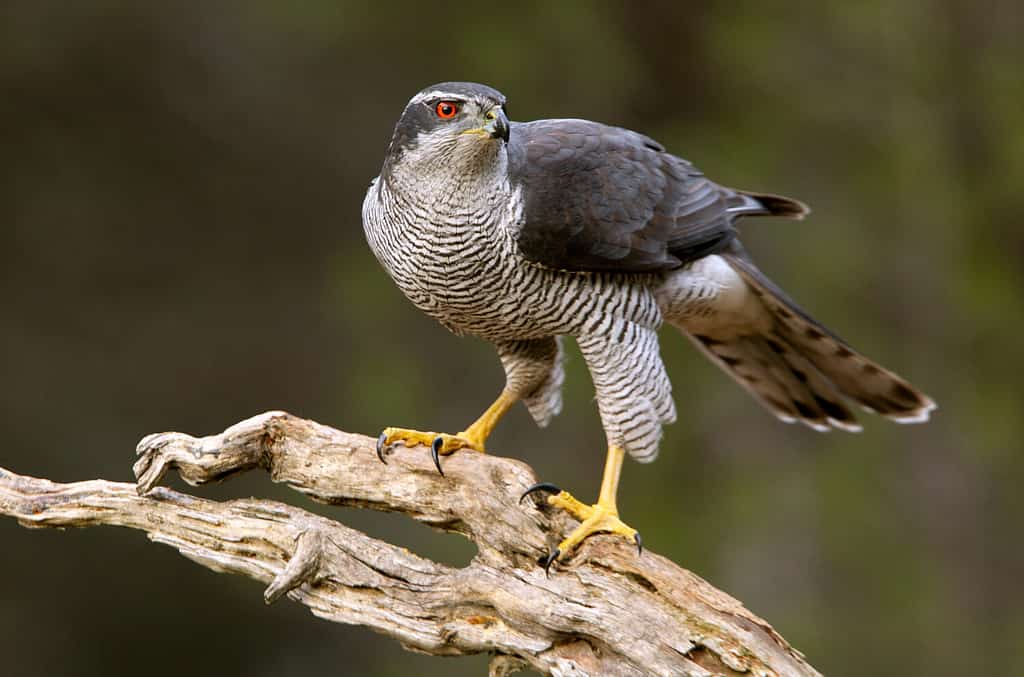
While smaller than other birds of prey, this species is known for being extremely fast.
©Jesus Giraldo Gutierrez/Shutterstock.com
The northern goshawk is another formidable raptor with exceptionally powerful talons. Therefore, they can pose a risk to humans, though they rarely do. Like most birds of prey, these birds can be aggressive during the breeding season, which typically occurs in the spring. They may be defensive towards humans during this time.
This species is known for its stealthy hunting tactics and sharp talons. They primarily hunt birds and small mammals, preferring densely forested habitats. Their hunting strategy involves sudden, rapid flights through dense foliage, using their agility to surprise and capture their prey.
In Minnesota, you’ll mostly find these birds in mature forests, particularly in the northern part of the state. Here, they can find plenty of coverage for hunting. However, this habitat also makes them a bit elusive for humans, who don’t see them as much as other birds.
As always, keep a respectful distance and minimize disturbances when in nesting areas. You don’t want to disturb nesting goshawks. Not only may they become aggressive, but you may also inadvertently cause harm to the chicks.
6. Turkey Vultures

Flying turkey vultures are pretty easy to spot, thanks to their vast size.
©GarySang/Shutterstock.com
There are few animals despised more than turkey vultures. Because they eat dead things, many people avoid them whenever possible. Their primary role, indeed, is to consume dead things, which makes them carrion feeders. To do this, they have several specialized adaptations, such as an acute sense of smell. With this smell, they can detect the scent of carrion from a long distance.
You may see them gliding through the skies in search of their next meal.
While eating dead things doesn’t seem very sanitary, their diet aids the ecosystem by recycling nutrients that would go to waste otherwise. They also help prevent the spread of diseases, which tend to congregate on decaying remains.
Turkey vultures are not considered a danger to humans or pets. They are generally docile birds and are more likely to retreat when confronted or approached by people. These birds are not predators; they are scavengers, and their primary focus is on finding carrion rather than hunting live animals.
However, they are dangerous in one way: vomit. If they are scared, turkey vultures may vomit up their stomach contents towards whatever scared them. It’s not 100% clear why they do this. It may just be to lighten their load, making it easier for them to escape.
That said, it’s also possible that the decaying stuff in their stomach mixed with extra-acidic stomach acid is enough to deter any predator.
7. Wasps
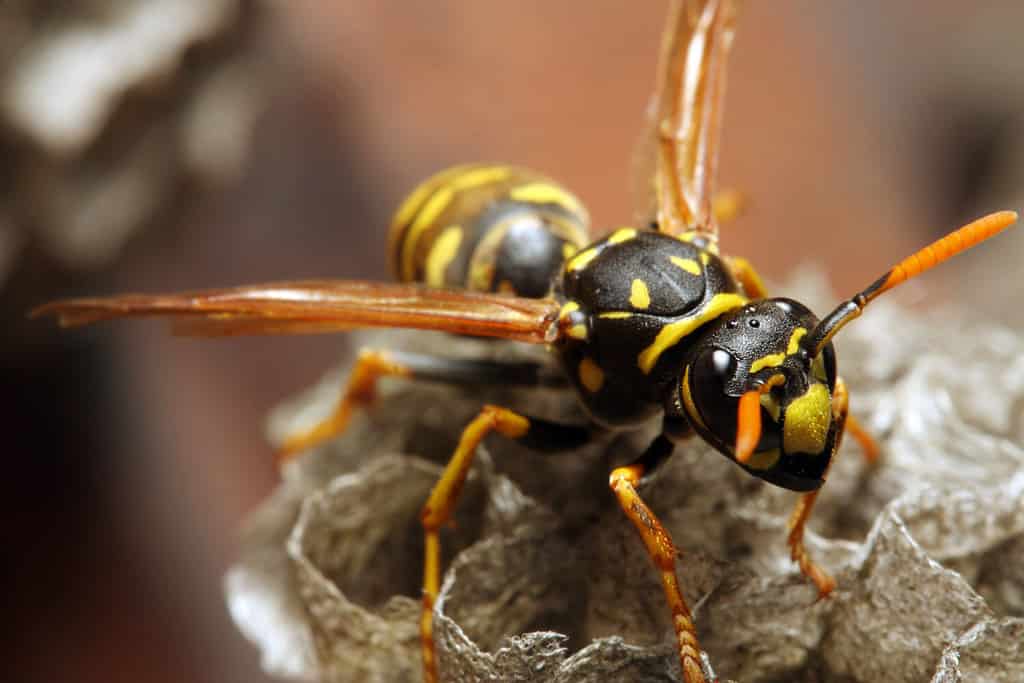
Yellow jackets are common throughout Minnesota.
©Kletr/Shutterstock.com
Minnesota is also home to a variety of insects, which can pose a risk to humans. One of the most notable of these insects is wasps, which have a powerful stinger. There are many species of wasps in Minnesota, including yellow jackets, hornets, and paper wasps.
Wasps are typically social insects that build nests. These nests may be in trees, on eaves, or underground. Typically, wasps are not aggressive but may start stinging if their nest is disturbed.
Their stings can cause allergic reactions in susceptible individuals. Otherwise, they are pretty harmless.
We recommend being vigilant and identifying wasp’s nests around your property. You should stay away from these nests whenever possible. Do not attempt to remove a nest. Preferably, you should leave it alone. If this isn’t possible, call a professional.
When engaging in outdoor activities where wasps might be present, wear protective clothing, such as long sleeves and pants, and avoid brightly colored clothing that can attract them.
If you encounter wasps, remain calm. Sudden movements can scare them and make them sting.
8. Mosquitos
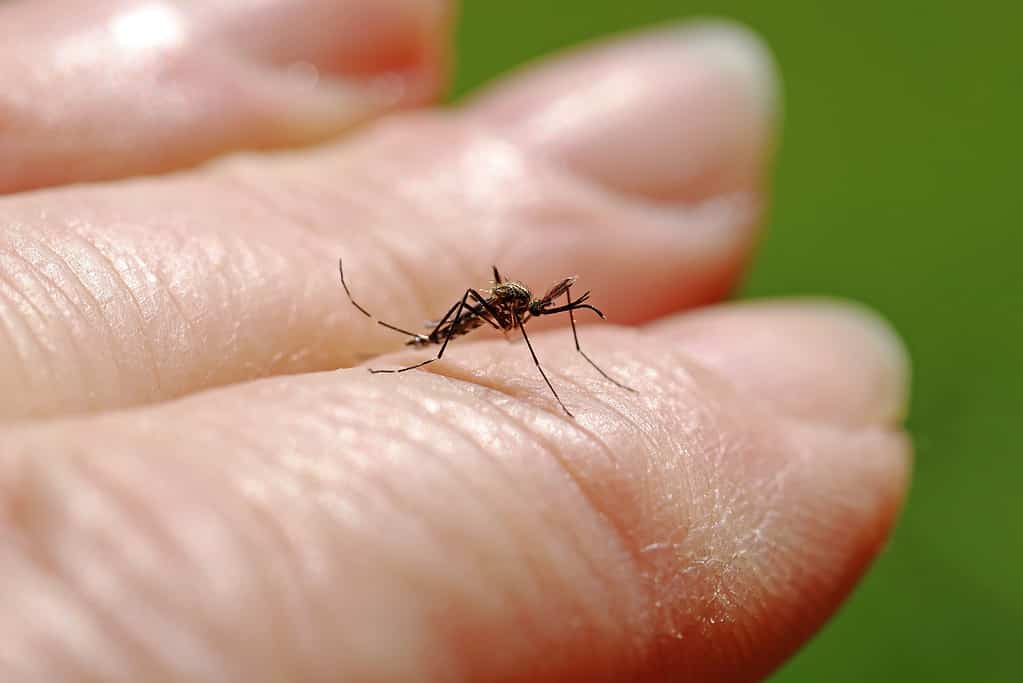
Mosquitos are a food source for birds, but when they bite humans, some types can cause malaria, Zika, and other deadly diseases.
©Astrid860/ via Getty Images
Mosquitoes are ubiquitous in Minnesota, especially during the warmer months. While their bites are a common nuisance, they also pose health risks due to their potential role in transmitting diseases. The bites are not typically dangerous, but many of these diseases are.
For instance, they may transmit West Nile virus and various kinds of encephalitis in the state.
We highly recommend taking precautions to minimize mosquito exposure during the warmer months. Use mosquito repellent containing DEET, picaridin, or other EPA-approved ingredients when spending time outdoors.
You should also wear protective clothing, like long sleeves, long pants, and socks.
Keep an eye out for potential mosquito populations around your property. Empty standing water in containers, gutters, and birdbaths regularly, as mosquitos will breed in these areas.
Summary of the Top 8 Most Dangerous Flying Animals in Minnesota
| Number | Animal |
|---|---|
| 1 | Bald Eagle |
| 2 | Great Horned Owl |
| 3 | Red-Tailed Hawk |
| 4 | Peregrine Falcon |
| 5 | Northern Goshawk |
| 6 | Turkey Vulture |
| 7 | Wasps |
| 8 | Mosquitos |
Thank you for reading! Have some feedback for us? Contact the AZ Animals editorial team.






